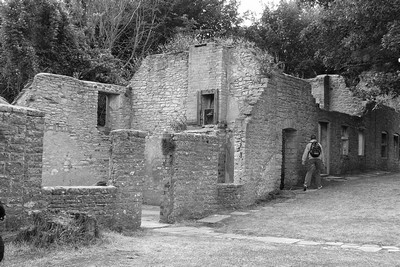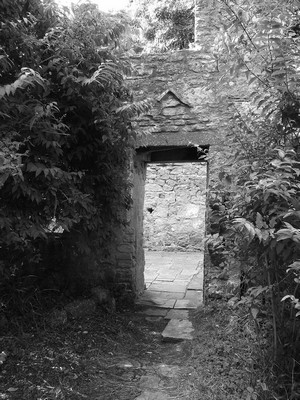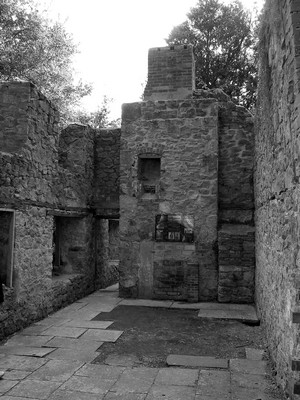 After all that rock-climbing and kite-flying on Portland we decided to visit Tyneham village. But first we had to find some shops so that Jayne could buy a fleece or jumper – somehow she forgot to pack one and it was getting quite nippy in the evenings.
After all that rock-climbing and kite-flying on Portland we decided to visit Tyneham village. But first we had to find some shops so that Jayne could buy a fleece or jumper – somehow she forgot to pack one and it was getting quite nippy in the evenings.
On the way through Weymouth we had noticed a Matalan and decided to have a look there as it would avoid having to go right into the centre. Having found a hoodie for six quid we set off for Tyneham, pausing only to pick up some groceries and some sandwiches for lunch.
Tyneham proved to be harder to find than we expected. The problem is that I was using a large road atlas which didn’t have a lot of the smaller roads on but after whipping out the OS map we did a lot better. Looking on the bright side, we did get to see even more of the countryside than we had intended.
The village of Tyneham is right in the middle of the army’s firing ranges. For most of the year it is inaccessible as all the roads to it are closed. During the summer the army stop playing with their tanks and the roads through the ranges are open. Also there are several walks across the ranges which are open. You can’t roam freely across the land, and wouldn’t want to with all that unexploded ordinance around, but you can follow the paths through some outstanding landscapes.
We drove around a bit, ending up at a picnic site on the ridge of a hill, where we had our sandwiches and enjoyed the views of two valleys, both dotted with range markers. I found all the red flags slightly un-nerving. They mark when you are going into the danger area even when there is no firing going on but you still worry a little bit.
 The village of Tyneham itself was forcibly evacuated in November 1943 as part of the war effort. The army wanted a place to test all their vehicles and tactics and Dorset was the place they chose – it was sparsely inhabited with land not suitable for large-scale agriculture.
The village of Tyneham itself was forcibly evacuated in November 1943 as part of the war effort. The army wanted a place to test all their vehicles and tactics and Dorset was the place they chose – it was sparsely inhabited with land not suitable for large-scale agriculture.
After the war the army decided that it wanted to keep the land for its training and testing and so the villagers never got to return to their homes. Now it is a sort of cross between a ghost town and an open air museum.
Only the church and schoolhouse are intact, the rest are in ruins. I imagine they were used for some sort of target practice. In recent years they have been made secure (what is left of them) and it is possible to walk around the village to get some idea of life in the 1940s in rural England.
If I had to sum up the place in one word it would be ‘poignant’. The villagers themselves felt badly treated as they had been promised a return to their homes after the war so there is a sense of injustice about the place. On the other hand it is fascinating to get some idea of the life they left behind.
 By today’s standards it does not seem like much of a life. The houses are tiny, with few rooms and very low ceilings.
By today’s standards it does not seem like much of a life. The houses are tiny, with few rooms and very low ceilings.
1943 is not so long ago – well within living memory of parents or grandparents – and yet life in Tyneham in 1943 did not seem too different from life in Tyneham in 1843.
Each building had a display in it with photos of the place when it was occupied and details of who lived there at the time and at earlier census times back to 1801. You would find, for example, that the occupant in 1943 was a farm labourer aged 73.
At first you think how good it is that someone should be so active at that age, but then you wonder why they kept on gonig and remember that this was before the welfare state and universal old age pensions.
The most shocking thing for me was reading in the church that the whole village and all its buildings were owned by the squire. The army gave him compensation for loss of land, but the villagers received only the value of any crops in their gardens. When they were shipped off they had only their clothes and furniture.
That is the clue as to why the men continued working well past a sensible retirement age – they could not afford to do otherwise. In effect the houses were tied accommodation and everything must have been in the gift of the local squire or lord of the manor. Although he could decide to allow an old person to continue living in their house, and I am sure some did, he could also arbitrarily turf anyone out of their homes to replace them with someone more productive. I had never thought about when the feudal system actually ended but had never thought about it being so much in evidence as recently as 1943.
 The whole place was a revelation to me, showing just how much we now have. Not necessarily in material terms but in terms of rights which we take so much for granted but which are only relatively recently granted – against much resistance from the landowning classes. It was also a reminder of how the typically idyllic English village can contain as much hardship as any inner-city sink estate, although today’s rural poverty would probably look like luxury to the inhabitants of Tyneham in the 40’s.
The whole place was a revelation to me, showing just how much we now have. Not necessarily in material terms but in terms of rights which we take so much for granted but which are only relatively recently granted – against much resistance from the landowning classes. It was also a reminder of how the typically idyllic English village can contain as much hardship as any inner-city sink estate, although today’s rural poverty would probably look like luxury to the inhabitants of Tyneham in the 40’s.
After Tyneham we returned to the campsite by the back roads, and spent the evening preparing and eating a massive barbecue.



No Comments so far ↓
Like the collective mind of the Daily Mail, comments are closed.